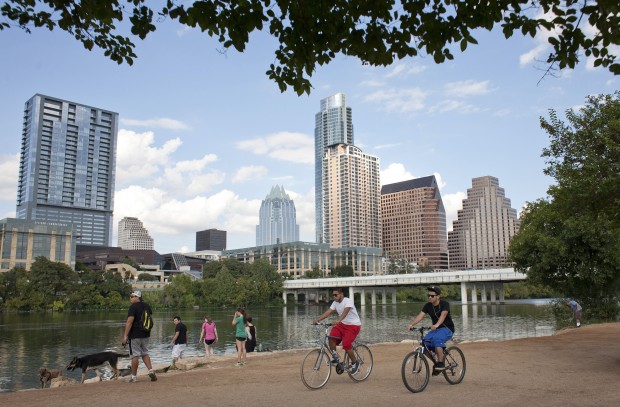Where Will Austin Go For Water Next?

REUTERS /JULIA ROBINSON /LANDOV
Cyclists pass beneath the downtown skyline on the hike and bike trail on Lady Bird Lake in Austin, Texas September 18, 2012. While traditionally an aesthetic pleasure, the lake could be used to help treat water.
The Highland Lakes, the main reservoirs for over a million people in and around Austin, are only a third full. They could reach their lowest levels in history this summer.
As the shores of those lakes receded during the Texas drought, businesses dried up and water quality declined. If you take a trip out to Lake Travis today, you’ll notice the most popular shorebird is the vulture. With the lake 46 feet below where it should be, there’s plenty of shoreline for them.
If the main water supply of a million people is at risk, what’s the ‘Plan B?’
“Unfortunately, there is no ‘Plan B,'” says state Sen. Troy Fraser (R-Horseshoe Bay). “We are totally dependent on Mother Nature in this area. It’s really a problem.”
But it’s a problem that finally seems to have gotten the attention of Austin’s city leaders.
The city’s main strategy to deal with the drought up until now has been conservation, and Austinites have answered the call. Per capita, the city is using less water than ever, according to Greg Meszaros, Director of Austin Water.
But rain continues to miss the lakes. Massive releases of water to rice farmers downstream that greatly reduced lake levels in 2011, the single driest year in Central Texas history, didn’t help either.
“Comparison-wise, about three years worth of Austin’s water use” was sent to rice farmers that year, Meszaros says.
Another silent straw is sucking up water from the lakes: evaporation.The lakes lose almost as much water to evaporation as the city uses every year. Now the city is starting to think about how to extend a shrinking supply.

Courtesy of CERES
Sharlene Leurig of CERES is chairing an effort to find small-scale options to extend Austin's water supply.
Leading part of that effort is Sharlene Leurig, Director of the Sustainable Water Infrastructure Program at Ceres, a non-profit specializing in sustainability. Leurig is chairing a new water resource task force under the direction of Austin’s City Council. Their aim is to find solutions that could boost Austin’s water supply.
“There’s no single project that will solve the challenge before us,” Leurig says. But there are a number of projects and tweaks that could significantly improve the situation. Forget big reservoirs: Austin is looking to get creative in finding more water.
Some of the solutions, Leurig says, are sitting right under Austin’s nose. Standing on the shores of Lady Bird Lake in downtown Austin, surrounded by joggers and gazing out onto the dog park at Auditorium Shores, Leurig says the pass-through lake is more than just an aesthetic treat for Austinites.
“Use this as a storage supply,” she says. “That might actually accept treated wastewater produced by the city of Austin for reinjection back into our drinking water system.”
Once treated, Leurig says, the water would be purer than bottled water. Several other cities in Texas, including Wichita Falls, Brownwood and San Angelo are moving forward with or considering wastewater reuse programs.
It’s just one of the many smaller solutions on the Austin water supply smorgasbord, Meszaros of Austin Water says.
“For example, what’s called Walter E. Long Lake, or Decker Lake [in East Austin], there’s no technical reason you couldn’t use that lake as a complement to the water supply,” Meszaros says.
Other ideas on tap? Here are a few being considered by the water resource task force:
- Fixing Longhorn dam to better control water flows.
- Lowering Lake Austin to catch more rainfall.
- Using aquifers underground to store water and prevent evaporation. Meszaros of Austin Water says the city would work to use land it could easily access in order to avoid potentially costly litigation.
- Rainwater capture, distributed throughout the city, especially on commercial buildings downtown.
- Using a biodegradable powder on the surface of lakes in Austin’s water supply to lower evaporation, starting with smaller lakes like Lady Bird Lake or Walter E. Long Lake.
- Securing groundwater access from the Carrizo-Wilcox or Northern Edwards aquifers.
There’s no “silver bullet,” Meszaros says. “There’s no golden barrel of water out there that is vastly available and very low cost. If it were, people would have it already.”
Meszaros estimates that the right mix of projects could add roughly a quarter to nearly three-quarters of Austin’s annual water use from the Highland Lakes.
Leurig of the Water Resource Planning Task Force says the answer to strengthening Austin’s water supply is likely an “all of the above” strategy.
Such a hodge-podge of projects — even small ones — will take time and money. Some are costlier than others (like aquifer storage and recovery), and how the city will prioritize and budget the projects remains to be seen. Austin Water is already preparing rate increases to make up for lost revenues during the drought.

Texas Tribune
State Senator Troy Fraser (R-Horseshoe Bay) says the region needs a 'Plan B' for its water supply.
“The unfortunate thing is, it doesn’t happen overnight,” says state Sen. Fraser.
“We’re about to go through a very hot, difficult summer that I’m very nervous about. Because this event we’re going through was preventable.”
The water resource task force has until June 20th to provide their recommendations to city council. What the council will decide to do then is an open question.
And the region’s water plan is undergoing changes that will likely result in far less water going to rice farmers during dry times. Meszaros of Austin Water says regardless, Austin will continue to rely on the Colorado system.
“The lakes aren’t going to run out of water in any immediate future,” he says. “But we’re gonna be in a potentially long-term situation where they’ll be at relatively low levels compared to their historic norms. Fundamentally, we’re going to be a Colorado River system water supply-driven community for many, many decades to come.”


